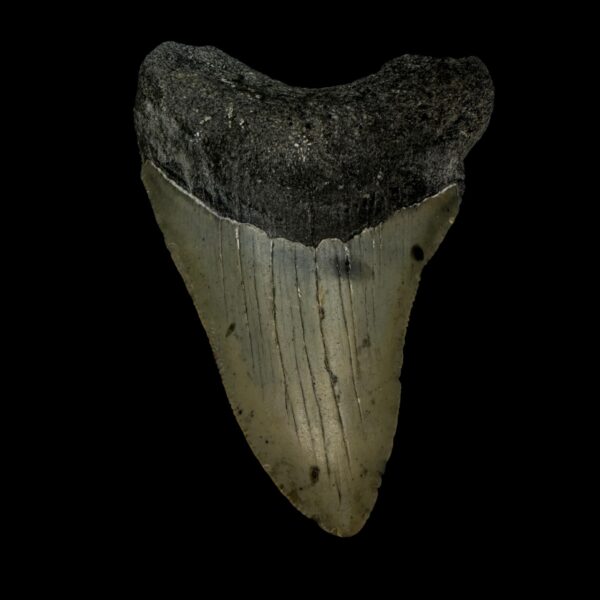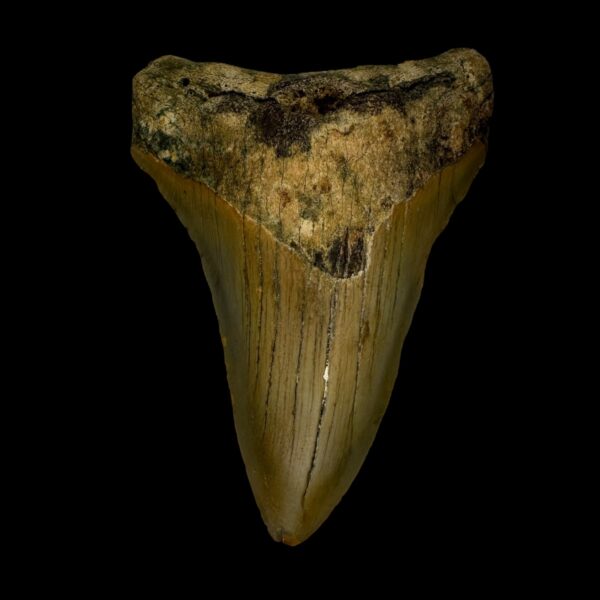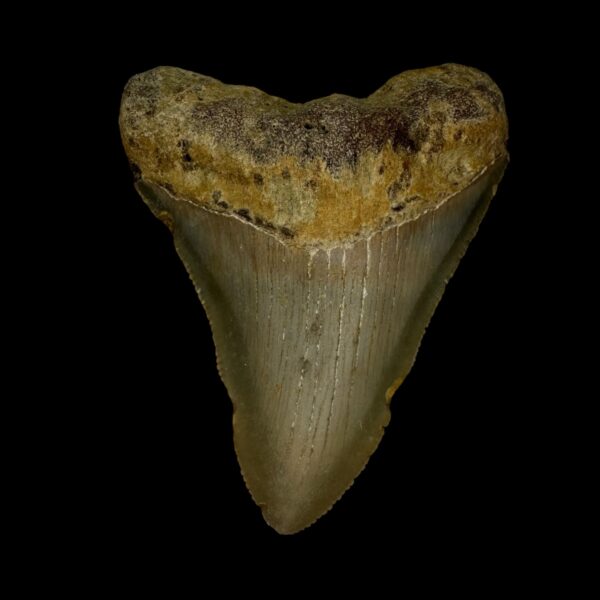The prehistoric megalodon shark, an apex predator of ancient seas, left behind one of the most collectible remnants: its teeth. But with the rise of popularity, fake fossils have flooded the market. That’s why knowing the differences in megalodon teeth real vs fake is essential for enthusiasts and collectors alike. Learning to identify megalodon teeth real vs fake will help you avoid fraud and value authentic pieces. If you’re passionate about collecting, understanding megalodon teeth real vs fake is your best defense.
The Science Behind Real Megalodon Teeth
Authentic megalodon teeth are fossils, which means they have gone through mineralization over millions of years. This gives them a distinct texture, weight, and appearance. A real tooth typically has a dense, heavy feel. Its coloration varies due to the minerals in the sediment where it was buried.
Real megalodon teeth often have a dark root, a sharp edge with fine serrations, and a smooth bourlette (the dark triangle between enamel and root). Each of these characteristics can help confirm authenticity. These details are key when analyzing megalodon teeth real vs fake. Comparing megalodon teeth real vs fake closely reveals how authentic traits differ from imitations.
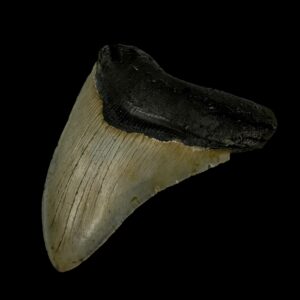
Spotting Fake Megalodon Teeth
Fakes come in various forms: molded resin replicas, modified modern shark teeth, or composite reconstructions. Here are key signs that point to fakes:
Uniform color: Real teeth rarely have a perfectly even tone.
Perfect shape: Fossilized teeth often have chips or wear marks.
Too light: Authentic fossils are typically heavier.
Another giveaway is polish. While some real teeth are lightly polished to enhance display, overly shiny surfaces may suggest resin replicas.
Learning to recognize common patterns in fake teeth improves your ability to differentiate megalodon teeth real vs fake more effectively. Experience and research help collectors become experts at spotting megalodon teeth real vs fake in various settings.

Where to Buy Authentic Megalodon Teeth
To avoid scams, only purchase from reputable fossil dealers. Ask for provenance and, when possible, a certificate of authenticity. Don’t be afraid to ask questions about the tooth’s origin.
Researching and consulting reliable sources is essential when comparing megalodon teeth real vs fake, especially when making online purchases. Ask experienced collectors for tips on identifying megalodon teeth real vs fake to improve your buying decisions.
Real vs Fake: Close-Up Examination
A hands-on examination is often the best way to spot the truth. Hold the tooth, examine the root, bourlette, and serrations closely. Pay attention to color inconsistencies, textural variations, and overall weight.
Some fakes are composites—meaning a real root attached to a fake crown or vice versa. Look closely at the seam between parts.
This type of visual and tactile analysis can make a big difference when distinguishing megalodon teeth real vs fake, even without specialized tools.
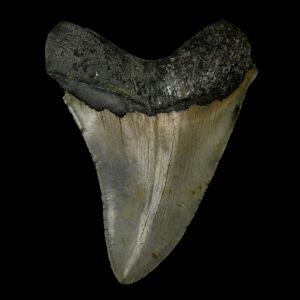
How to Know if a Megalodon Tooth is Real
Distinguishing between an authentic and a fake megalodon tooth may seem complicated, but with a few key tips, any collector or enthusiast can learn how to know if a megalodon tooth is real. Here are the essential elements to consider when identifying a genuine megalodon tooth:
Characteristics of an Authentic Megalodon Tooth:
Weight and density: A real tooth is significantly heavier than a replica due to the mineralization process that occurs over millions of years.
Natural color: Colors vary depending on the minerals in the sediment where it fossilized. Dark, gray, brown, or even black tones are common. A too-uniform or overly bright color can be a sign of imitation.
Defined bourlette: This is the dark strip between the root and enamel. In genuine teeth, the bourlette is usually well-marked and distinct.
Fine serrations: The edges of a real tooth often have small serrations (saw-like teeth) that can be felt or seen under a magnifying glass.
Porous but solid root: Unlike replicas that may have completely smooth roots, real teeth have a granular or porous root texture.
Signs That It Might Be a Fake Tooth:
Too light: If it feels light when held, it’s probably not a true fossil.
Shiny surface: Excessive shine or polish may indicate it’s made of resin or another artificial material.
Lack of natural wear: A perfectly symmetrical tooth with no cracks or worn edges might be a molded replica.
Learning how to know if a megalodon tooth is real not only enhances your experience as a collector but also protects you from fraud and costly purchases of valueless items. Familiarizing yourself with the details that characterize authentic megalodon teeth is key for any fossil lover. Over time, your eye will become trained to detect subtle differences that make all the difference.
You can also visit museums or fossil fairs where authentic pieces are exhibited. These experiences help you visually compare and recognize the differences. Many collectors say that after seeing several real examples, it becomes much easier to identify a genuine megalodon tooth. Additionally, talking to experts or joining online communities can be very helpful if you’re just starting. Sharing photos, asking for opinions, and learning from others can prevent costly mistakes. Remember that investing time in learning how to know if a megalodon tooth is real is just as valuable as the purchase itself. In summary, observation, touch, and knowledge will be your best allies in distinguishing between a replica and an authentic prehistoric treasure.
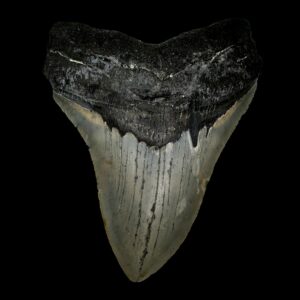
Collector Tips and Preservation
Once you have a verified real megalodon tooth, proper care is essential to preserve its condition. Store it in a dry environment, away from direct sunlight and moisture. Fossil-grade display cases or shadow boxes with acid-free backing are great for showcasing your piece while protecting it.
If you clean your fossils, use only a soft brush and never harsh chemicals, as they can degrade the enamel or root over time. A gentle dusting is often all that’s needed to maintain their beauty.
Some collectors also prefer to keep a log of their specimens, including information such as where and when they were acquired, the seller’s name, and any authenticity certificates. This adds provenance and value over time.
Megalodon teeth can also be part of educational kits or family collections. Sharing the story of the megalodon and the differences between megalodon teeth real vs fake can be a fun and educational activity for all ages. Some museums even offer workshops on fossil identification, which are excellent for building expertise.
Don’t forget to insure high-value fossils. Many collectors overlook this step, but insurance protects your investment in case of loss or damage. Some fossil dealers can even help appraise the teeth for insurance purposes.
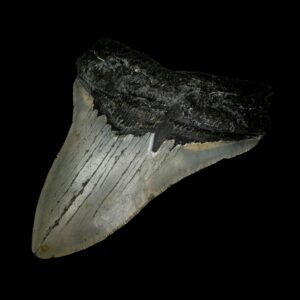
Megalodon Tooth Market Trends
In recent years, the market for megalodon teeth has grown rapidly. The rise of online marketplaces has made it easier to find specimens, but also easier for counterfeit items to spread. High-quality real teeth can range from $50 to thousands of dollars depending on size, condition, and rarity.
Larger teeth over 6 inches in excellent condition are especially valuable. The symmetry of the tooth, intact bourlette, and fine serrations increase its desirability. However, with rising prices comes the increased risk of encountering fakes, making knowledge your best defense.
Collectors should also be wary of restoration. Some dealers repair broken teeth or repaint enamel to improve appearance. While these may still contain genuine fossil material, it’s important to disclose any enhancements, especially if the item is sold as authentic.
Many seasoned collectors advise beginners to attend fossil shows. These events allow you to see and handle real megalodon teeth side by side with potential fakes. Meeting sellers in person and asking questions face-to-face can make all the difference.
Social media groups dedicated to fossils and paleontology are another valuable resource. Members often share advice and photos that illustrate how to spot megalodon teeth real vs fake more clearly. Mastering this comparison between megalodon teeth real vs fake will allow you to make informed choices when acquiring new pieces.
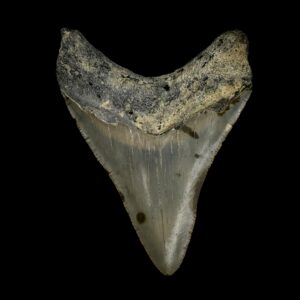
Educational and Scientific Importance
Beyond their role in collections, megalodon teeth hold immense scientific value. They provide data on the diet, migration patterns, and growth stages of one of history’s most formidable marine predators. Universities and museums often analyze the chemical composition of these fossils to better understand ancient marine ecosystems.
Each discovery contributes to a growing database, helping paleontologists piece together how the megalodon lived, hunted, and eventually went extinct. The more we understand real fossils, the better we can distinguish them from fabrications.
Public exhibits, documentaries, and even school programs often rely on verified real fossils to educate future generations. The awe inspired by a genuine megalodon tooth is unmatched, making authenticity vital for educational integrity.
Outreach programs often include mobile fossil displays or science kits for classrooms. These interactive methods let students compare megalodon teeth real vs fake, sparking curiosity and inspiring future scientists.
Many institutions have now started digitizing their fossil collections, providing online databases and high-resolution images for public access. This trend helps global collaboration and transparency in fossil identification.
Final Thoughts
Identifying megalodon teeth real vs fake is a skill that develops with experience. While the differences might be subtle at first, becoming familiar with authentic teeth will train your eye to notice fakes.
If you’re new to collecting, start small and buy from trusted sources. Study photos from scientific references and authentic collections to get a feel for what a genuine fossil looks like. Comparing multiple examples will help you master the difference between megalodon teeth real vs fake. Explore, examine, and gain confidence in your ability to tell megalodon teeth real vs fake.
© 2025 The Fossil Exchange. All rights reserved.


